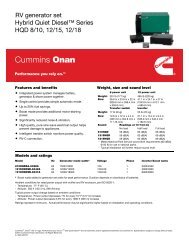Air Brake Manual
Air Brake Manual
Air Brake Manual
You also want an ePaper? Increase the reach of your titles
YUMPU automatically turns print PDFs into web optimized ePapers that Google loves.
S-cam <strong>Brake</strong> Adjustment with <strong>Manual</strong> Slack Adjuster<br />
· Ensure vehicle is secure and wheels blocked,<br />
release the parking brake.<br />
· Verify system is at full pressure.<br />
· Use a proper wrench to disengage the external<br />
locking device (if so equipped) from the adjustment<br />
bolt of the slack adjuster.<br />
· Turn the adjustment bolt until the lining contacts the<br />
drum and the adjustment bolt will not turn any<br />
further. If possible, visually check to see that the<br />
brake linings are in contact with the brake drum.<br />
Pull or pry on the slack adjuster. There should be no<br />
movement or free play. If there is free play, you have<br />
turned the adjusting nut the wrong way.<br />
· When turning the adjustment bolt on the slack<br />
adjuster, the S-cam should turn in the same<br />
direction as if a brake application were being<br />
made.<br />
· Back off the adjustment bolt about 1/4 to 1/2 of a<br />
turn and ensure the locking device reengages.<br />
· Now recheck slack adjuster travel. The travel<br />
should now be between 1/2 to 3/4 inches free travel<br />
while pulling on the linkage, or within<br />
manufacturer’s specifications.<br />
Note: Applicants conducting an air brake examination<br />
will be required to satisfactorily adjust S-cam brakes<br />
with manual slack adjusters.<br />
The equipment required to adjust a brake must be<br />
supplied by the applicant.<br />
S-cam <strong>Brake</strong> with Automatic Slack Adjuster<br />
Automatic slack adjusters adjust themselves during<br />
brake applications to accommodate for brake lining<br />
and drum wear. However, they must be checked<br />
daily to ensure they are maintaining proper push rod<br />
travel which normally is two inches when the brake<br />
is applied. Normally two to four brake applications<br />
of 80-100 psi per day will keep the brakes properly<br />
adjusted, a driver may be required to consciously<br />
make these applications when starting out for the<br />
day or during the trip when possible. If they are<br />
badly out of adjustment, a qualified mechanic should<br />
inspect them. Adjusting automatic slack adjusters<br />
by hand is not recommended unless you are<br />
thoroughly trained on the proper adjustment<br />
procedures as dictated by the manufacturer. If an<br />
automatic slack adjuster requires adjusting by hand<br />
the slack adjuster may not be working properly and<br />
should be inspected or replaced by a qualified<br />
mechanic as soon as possible.<br />
Disc <strong>Brake</strong> Adjustment<br />
There are a number of makes and models of air disc<br />
brakes, each with a different adjustment procedure.<br />
It is therefore recommended that you consult the<br />
manufacturer’s manual for adjustment or service.<br />
Wedge <strong>Brake</strong> Adjustment<br />
<strong>Manual</strong> adjusters:<br />
· Hoist or jack wheels off the ground.<br />
· Remove dust cover from adjusting slots at two<br />
places on each brake. On twin chamber units the<br />
68




